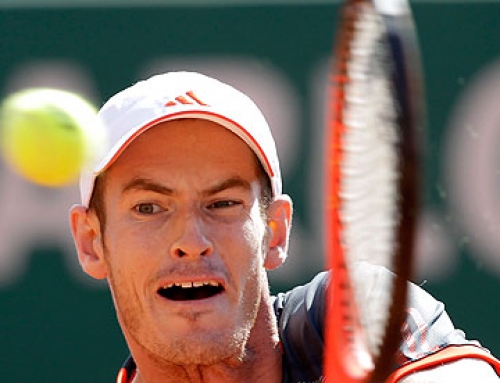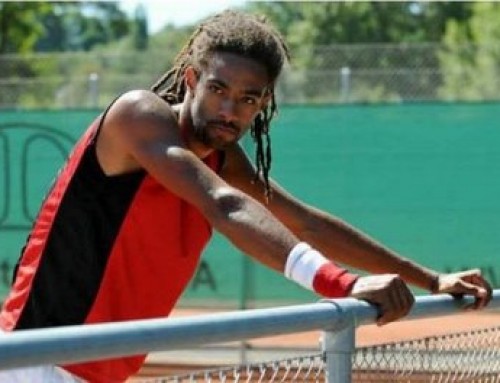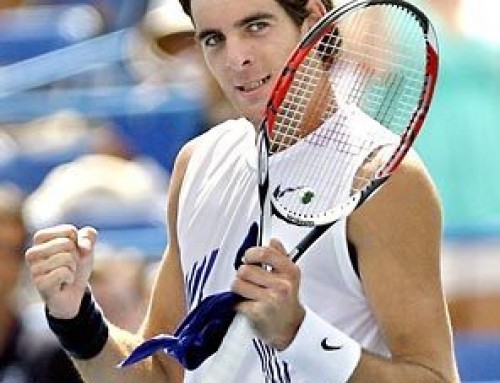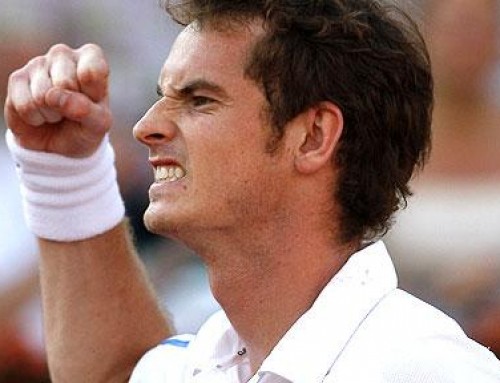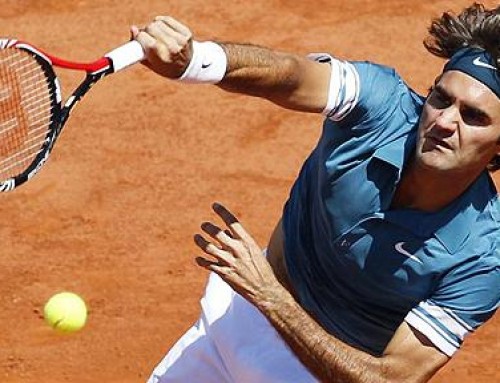 The clay season leading to the French Open is nearly over. The third of the Masters 1000 clay events will have its final tomorrow. The three tournaments in 2009 are: Monte Carlo, Rome, and Madrid. Madrid was an indoors event but was recently changed to clay, held at the new Magic Box arena, replacing Hamburg which was demoted to an ATP 500 event.
The clay season leading to the French Open is nearly over. The third of the Masters 1000 clay events will have its final tomorrow. The three tournaments in 2009 are: Monte Carlo, Rome, and Madrid. Madrid was an indoors event but was recently changed to clay, held at the new Magic Box arena, replacing Hamburg which was demoted to an ATP 500 event.
The story of these three tournaments have boiled down to these two guys: Rafael Nadal, world number 1, and Novak Djokovic, world number 4. Djokovic recently slipped to 4th when he was unable to defend Rome, behind Andy Murray.
Although Andy Murray is number 3, clay is Murray’s weakest surface. His style of play, while effective on faster surfaces, is a bit too passive for clay. Murray plays an odd style of tennis. If Nadal has been criticized for waiting for the unforced error, he’s not in the same league as Murray. Nadal can hit amazing shots in neutral to precarious situations. Murray meanwhile hits neutral shots. Strong clay courters have pushed Murray around, making Murray look like a deer lost in headlights.
And Roger Federer? Although he’s been the world number 2, aarguably the second best clay courter in the world, his clay court season in 2009 has been spotty. He lost to countryman, Stan Wawrinka, in the third round of Monte Carlo. In Rome, Federer lost to Djokovic in three sets in the semifinals. Because he’s still number 2, he’s always on the opposite half of the draw, and thus hasn’t met Nadal no clay. Madrid will be the first match Federer has played Nadal since January.
Based on tournament results, he two best players on clay this year has been Novak Djokovic and Rafael Nadal.
To say the competition has been close, well, it’s been close for a set and a little more. It’s quite telling when people feel Djokovic is the best guy to beat Nadal and still has lost 6-1 and 6-2 sets
against him.
Djokovic took a set off Nadal in the finals of Monte Carlo, quite a feat as Nadal had not dropped a set in Monte Carlo in years. Although Djokovic played strongly in the third set, having opportunities to break Nadal and hold his own serve, Nadal won every critical point, and finally ran away with the set, 6-1.
They met again in the finals of Rome where Djokovic struggled on serve in the first set, but managed to break Rafa and force a tiebreak. The tiebreak went easily to Nadal. And much like a repeat of Monte Carlo, Djokovic had chances to keep the second set close, but ultimately, Nadal ran away with the second set, 6-2.
This clay court rivalry has been a kind of redemption for Djokovic, at least for the tennis savvy fan. Djokovic has been criticized for his health issues, having retired several times. It’s been joked that he might complete a Grand Slam in retirements having dropped out 3 of 4 Grand Slams. Recently, he’s working with a trainer to try to improve his fitness, so he doesn’t retire nearly as much as he does. Fitness was also a problem that plagued Murray, one he rectified when he began seriously dealing with fitness and training in late 2007.
Djokovic’s reputation as a likable player took a serious hit, at least among Americans, due to an incident at the US Open. Prior to this match, Djokovic won a five-set thriller against Spain’s Tommy Robredo. Robredo was none too happy with Djokovic’s numerous call to trainers, insinuating Djokovic wasn’t really ill, but simply unfit. When asked about it Roddick started making jokes claiming Djokovic must have a laundry list of illnesses, like SARS.
Djokovic was none too happy about his comments, which he likely heard second-hand, and made a point of it after beating Roddick. Not surprisingly, the largely American audience turned against Djokovic booing him for making such critical remarks, and this seems to have surprised Djokovic. It may have played a small role in his loss to Federer in the semifinals. When he should have been concentrating on beating Roger, he was fighting off negative press fallout.
If Djokovic is going to rehabilitate his image, beating Nadal might be the way to do it. Djokovic has been taking tests that Nadal has admistered. Each time, Djokovic has done well, but not passed the test.
To Djokovic’s credit, he knows he has the kind of game that can beat Nadal. He knows that, unlike Verdasco, he’s mentally tough enough to at hang in with Nadal most of the times. Despite a lopsided head-to-head record, Djokovic keeps working at getting his game to the point where he can beat Nadal.
Their rivalry isn’t Andy Roddick vs. Roger Federer, where Roddick just hopes things align so he can beat Roger. Roddick knows he doesn’t have enough game to bother Federer, and the only way to beat him is for Roger to have a bad day. On the other hand, Djokovic knows if he is having a pretty good day, he can challenge Nadal.
Madrid is the third test of Djokovic vs Nadal. And this time, Djokovic had his best chance ever. Unlike his previous two meetings, Djokovic faced Nadal in the semifinals.
Several things helped Djokovic keep this match tantalizingly close. First, Nadal started off poorly. Nadal is stingy on errors, but he was tossing lots of errors off his forehand in the first set. Second, Madrid is played in altitude. That, combined with court conditions make Madrid as close to a hardcourt as one gets for a clay court. And Djokovic plays pretty good on hardcourts.
Djokovic started the match off well with an immediate break. He held the break lead and won the first set, 6-4. Nadal called for a trainer who massaged his leg and wrapped it up.
The second set was tighter. Neither player lost serve. Djokovic played as well as he did due to superior serving. Nadal took the second set in a tiebreak rather easily.
Unlike the previous matches, Djokovic did not crumble early in the third set. Indeed, he broke early, but then gave the break back. Djokovic continued to pressure Nadal in the third set, and even had a 15-40 game on Nadal, one that Nadal came back and won.
Nadal is most dangerous when he’s down. If he needs a point, his level of aggression goes up. You can classify Nadal’s strokes into neutral, near winner, and winners. Nadal hits more near-winners than any other player. These are shots where the opponent gets the ball back, but often barely gets the shot back, leading Nadal to an easy shot that he pounces on. He does this so well that players have to train to deal with this shot and have a reasonable reply.
Djokovic handles these shots as well as anyone on tour. It helps that he has a two-handed backhand and can do more with shots to his backhand than, say, Roger Federer.
In the third set, Djokovic faced break points. Taking a page out of Nadal’s book, Djokovic played very aggressive, taking the game to Nadal and winning these games. Playing aggressive against Nadal is a risky proposition. If you are too aggressive, you make errors, and hand games to Nadal. Djokovic has just enough consistency that he can hit hard aggressive shots and not make too many errors. He’s not in the same league as Nadal, but for that style of play, he’s probably Nadal’s closest rival.
Djokovic pushed Nadal to a third set tiebreak. Could Novak finally beat Nadal?
Here’s an interesting stat. Djokovic has never won a tiebreak against Nadal. To be fair, in their 18 meetings, they’ve only ever played 5 tiebreakers, and 2 of them were in the Madrid semifinals.
This tiebreak was tantalizingly close with Djokovic had several opportunities to win the match. If anything, Nadal’s superior serving at break points helped keep Nadal in the tiebreak. When Djokovic had opportunities, Nadal became the aggressor and hit amazing shots.
What Nadal does better than anyone in the world is to play huge shots at huge moments. This is the sign of a great champion. Obviously, if he wilted in such situations, he wouldn’t be number 1, but it’s a testament to Nadal’s skill as a player, both mental and physical, that he wills himself to win crucial points.
The 11-9 win in the tiebreak is as good a tiebreak as you’ll see, and Djokovic had the match on his racquet several times. This defeat has to be hugely discouraging, and yet, Djokovic needs to realize he’s close, he’s close, he’s close, and keep working at his game.
Many would say this incredible match should have been the final.
Except.
Except that Roger Federer finally beat the players he should have beaten and made it to the finals. Federer hasn’t played Nadal since the Australian Open. The prior two meetings were at the French Open final and Wimbledon final. And it’s mostly been Federer who has been unable to make finals to meet Nadal.
If Federer is going to win, and the likelihood seems remote, he’ll do it through big serves, and taking his game to Nadal. He can’t slip mentally and start spraying shots as he’s done against nearly all his top rivals. Nadal may have to help out by playing subpar.
One can only hope the intrigue to this final is matched by the actual play. Alas, it’s going to be very hard to top the semifinal match, and that odds are, it will be far less than exciting. I can only hope that I’m wrong, and the finals top the semis.



